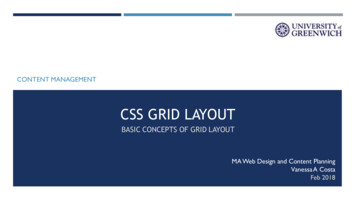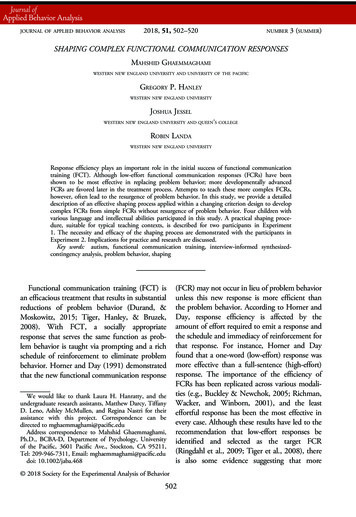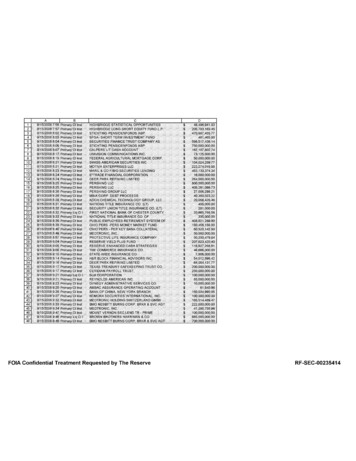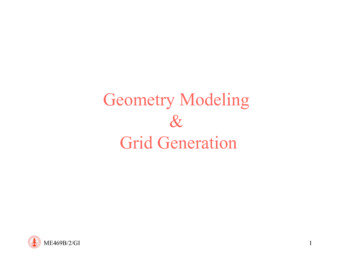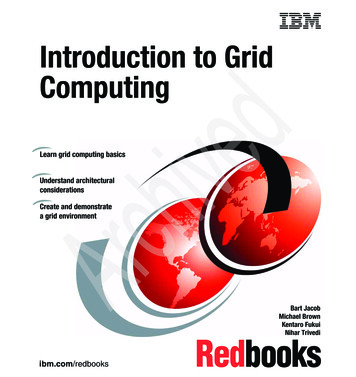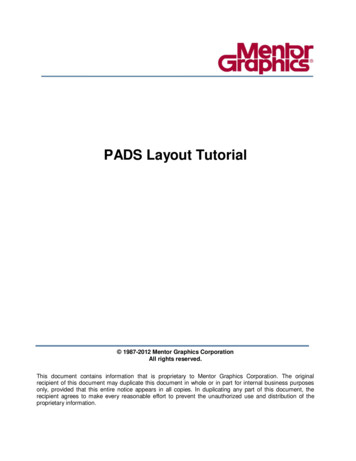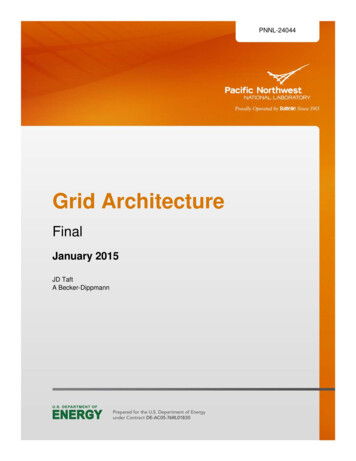
Transcription
PNNL-24044Grid ArchitectureFinalJanuary 2015JD TaftA Becker-Dippmann
PNNL-24044
PNNL-24044Grid ArchitectureRelease 3.0January 2015Prepared forthe U.S. Department of Energyunder Contract DE-AC05-76RL01830Pacific Northwest National LaboratoryRichland, Washington 99352
Contents1.0 Background and Purposes .1.12.0 Scope and Focus of This Work.2.13.0 Brief Introduction to Grid Architecture .3.13.1 How Grid Architecture Can Be Used .3.33.2 Why Grid Architecture Should Be Used .3.34.0 Starting Point: Selected Architectural Representations of the Existing Grid .4.14.1 Macro Structure .4.14.2 Industry Structures .4.54.2.1 Vertically Integrated Utilities .4.64.2.2 ISO/RTO-based Utilities .4.84.2.3 Public Power/Municipal Utilities/Electric Cooperatives.4.94.3 Markets, Services, and Business/Value Stream Frameworks . 4.124.3.1 Value Stream Structure for Vertically Integrated Markets. 4.134.3.2 Value Stream Structure for Hybrid Markets . 4.144.3.3 Value Stream Structure for Texas . 4.154.3.4 Value Stream Structure for Independent Aggregator Markets . 4.164.3.5 Value Attachment . 4.174.4 Electric Structure . 4.204.4.1 Transmission/Bulk Power System Structure . 4.234.4.2 Primary Substations. 4.234.4.3 Distribution Circuits . 4.244.5 Basic Electric Coupling Model . 4.284.6 Dynamic Interaction Model . 4.304.7 Control/Coordination Framework . 4.335.0 Selected Architectural Views for the Grid of 2030 .5.15.1 Desired Qualities List .5.15.2 Key System Properties Supporting These Qualities.5.35.3 Key Future Grid Components and Structures .5.35.3.1 Mappings .5.55.3.2 Selected Architectural Elements .5.85.3.2.1 Buildings .5.85.3.2.2 Microgrids . 5.105.3.2.3 Storage . 5.115.3.2.4 Whole Grid Coordination . 5.145.3.2.5 Industry (DSO) Model and Distribution System Operators . 5.185.3.2.6 Flexible Distribution Circuits . 5.24iii
6.0 Case Studies.6.16.1 Storage as System Inertia Augmentation in a Multi-Services Environment .6.16.2 Electricity/Natural Gas Interaction.6.26.3 Advanced Flexible Distribution .6.57.0 Conclusions .7.17.1 Industry Structure .7.17.2 Business/Value Streams .7.17.3 Electric & Power System Structure .7.27.4 Control/Coordination Framework .7.37.5 Grid Architecture 2030.7.3Appendix A - Architectural Principles.A.1Appendix B - Glossary.B.1Appendix C - Basic Quantitative Assessment of Architectures: Map Analytics .C.1Appendix D - Definitions of DOE Desired Grid Qualities .D.1Appendix E - Fundamental Basis for Laminar Coordination .E.1Appendix F - Works Reviewed for This Project.F.1Appendix G - Emerging Utility Industry Trends .G.1Figures3.1 Relationship of Architecture to Qualities .3.13.2 Architecture Development Process Inputs and Outputs .3.23.3 Architecture Process Flow .3.34.1 US Interconnections .4.14.2 Reliability Regions and Balancing Authorities.4.24.3 Texas Distribution Utility Service Areas .4.34.4 Geographic Encapsulation .4.44.5 Vertically Integrated Structure Model .4.74.6 ISO/RTO-Based Industry Model .4.94.7 Public Power/Municipal/PUD/Cooperative Structure Model . 4.104.8. Vertical Integration Value Stream Structure. 4.134.9 Hybrid Markets Value Stream Structure. 4.144.10 Texas Value Stream Structure . 4.154.11 Energy Services/Aggregator Value Stream Structure . 4.164.12 Value Attachment in ISO/RTO-Based Markets. 4.184.13 Basic Electric Structure . 4.214.14 Transmission Circuit Meshing . 4.23iv
4.15 Substation Bus Structures . 4.244.16 Typical Radial Feeder Structure . 4.254.17 Common Distribution Looping Arrangements . 4.264.18 Dense Urban Distribution Circuit Mesh . 4.274.19 Basic Direct Electric Coupling . 4.294.20 Grid Coupling Structure. 4.314.21 Whole Grid Control Model . 4.354.22 Bulk System Control/Market Integration. 4.364.23 Grid Coordination Structure . 4.375.1 Mappings for the Partial Architecture.5.65.2 Tracing the Impact of Laminar Coordination on Qualities .5.75.3 Tracing Storage Impact on Robustness.5.85.4 Coordination Node and Domain . 5.165.5 Essential Coordination Structure . 5.175.6 Mapping Laminar Coordination to Grid and Buildings . 5.185.7 DSO Industry Structure . 5.205.8 Uncluttered DSO Model . 5.215.9 Clarified DSO Structure. 5.225.10 DSO-Based Coordination Structure . 5.235.11 DSO Value Stream Structure . 5.245.12 Flexible Distribution Grid Structure Illustration . 5.266.1 Combined Grid Damping and Virtual Inertia from Storage .6.16.2 Electric and Gas Infrastructure Overlay .6.36.3 Loop Isolation in Gas/Electric Networks .6.36.4 Effect of Midstream Generation .6.46.5 Flexible Distribution Circuit .6.5Tables4.1 Power System Services Definitions and Properties . 4.195.1 Key Grid Components .5.45.2 Key Grid Structures .5.55.3 Key Building Characteristics .5.95.4 Key Microgrid Characteristics . 5.105.5 Storage Application Characteristics . 5.115.6 Flexible Mesh Elements. 5.25v
1.0 Background and PurposesThis work was done at the request of the U.S. Department of Energy (DOE), specifically with respectto issues relevant to U.S. electric transmission, storage and distribution infrastructure. This work hasseveral purposes: To provide organized views and insights about the existing U.S. grid as a means of identifyingstructural constraints to grid modernization; To provide selected potential future views of portions of grid architecture that address importantemerging trends and systemic issues; To help identify issues that may have public policy implications; To explain and illustrate the principles of system architecture, and apply those principles to modelpotential futures of the electricity system. Such an exercise links the components, structures andproperties of the system to specific system qualities that operationalize desired outcomes or objectivesof public policy.In the course of this work, two comment sessions were held with representatives of the utilityindustry, as well as DOE. The inputs provided in those sessions were very helpful in shaping the contentof this work, as were the many discussions with DOE officials and staff, members of nationallaboratories, and the key persons from the utility industry, both during and outside the comment sessions.Why Read this Document?This document, while only representing a beginning of the task of creating a full U.S. electric gridreference architecture, provides a number of key insights into existing limitations of the 20th Century gridvs the needs of the 21st Century grid, many of which are not recognized as the essential structurallimitations that they actually are. It also provides selected views into a possible future where the grid(especially at the distribution level) becomes a platform for energy innovation, with coordination (notcentralized command and control) of many types of resources, allowing multiple control and marketmechanisms and approaches to coexist on and connected to the grid simultaneously withoutcompromising electric reliability. Finally, it illustrates how the formal discipline of system architecture inthe specialized form of grid architecture makes it possible to devise rigorous architectures, to understandthe impact of various architectural choices on resulting system qualities, and to evaluate architecturaloptions and competing architectures quantitatively.Throughout the paper architectural insights and policy implications are identified in colored textboxes; key questions are identified and answered in text boxes as well, all in order to highlight takeaways.It is not the contention of this document that there is exactly and only one “best” architecture butrather that the use of these methods makes it possible to find good architectures for the grid, to understandcost-constrained tradeoffs, and to shape the essential guidelines and “rules of engagement” by which thegrid should evolve in the 21st Century.1.1
2.0 Scope and Focus of This WorkFull grid architecture has many aspects, some of which exceed the scope of this limited work.Instead, guidance from DOE led to the consideration of a subset of grid architecture issues, based on theircentrality to understanding key structural considerations and their linkage to critical emerging trends. Asa result, this paper describes a “partial” architecture, which focuses on the following areas: Electric structure/grid topology; Industry structure; Coordination framework; Business/Value streams; Electric/gas interactions; Buildings, microgrids, storage, power flow control/conversion, distributed generation; and Potential impacts on regulation and markets.Since this document describes a partial architecture, some topics that are clearly related will not becovered in any depth. This does not mean they lack importance; it simply means that those topics did notfall within the requested scope of this work or could not be treated in detail due to time limitations.However, where necessary, those areas were given consideration in the process of creating the structuremodels provided in this paper.Section 3 contains a brief discussion on basic aspects of system architecture as it is applied to powergrids. It focuses on the relationships of grid components and structures to the resultant properties of thegrid and how they support the desired system qualities determined by end user needs and public policy.Section 4 provides a set of architectural views for the U.S. grid as it exists today. These views areused to point out various structural limitations that must be addressed for the grid of the 21st Century.Specific issues illustrate these limitations, but it is not the purpose of this section to resolve those issuesindividually.Section 5 then introduces a partial architectural model using desired grid qualities provided by DOE.Selected forward-looking architectural view involving three specific structures and three advancedcomponents are used to illustrate how grid architecture organizes system complexity and how newstructures can address limitations in the grid.Section 6 contains three case studies: one for use of fast storage to augment system inertia, one toillustrate the interconnection and convergence of two related networks, namely the electric and gasnetworks, and one to illustrate the emerging concept of flexible distribution grids.Section 7 contains a summary and conclusions.Several appendices are located at the end of the paper, including a Glossary. Appendix F contains atable of prior and current works in the area of power grid architecture – these were reviewed andconsidered in the process of creating this document and some comments on their impact is included.2.1
3.0 Brief Introduction to Grid ArchitectureIn this section, the concept of formal system architecture is introduced as a general methodology andtool set, and then the specialization of this to electric power grids, grid architecture, is introduced.System architecture is a discipline for describing, analyzing, and communicating structuralrepresentations of complex systems. Colloquially, a system architecture is a model of a (complex)system, the purpose of which is to help think about the overall shape of the system, its attributes, and howthe parts interact. In the development of complex systems, the creation of architecture precedes systemdesign.Some uses of system architecture include: Managing complexity and therefore risk; Identifying gaps in theory or technology; Communication among stakeholders (internal and external); Untangling emergent ambiguity in organizational roles and responsibilities related to new functions; Enabling prediction of system qualities; Reducing or eliminating structural barriers to functionality and value stream formation; Determining convergences, and analyzing changes to system structure.System architectures consist of descriptions of abstract components, structures, and externally visibleproperties of a real or proposed system. These are combined to provide a system with a defined set ofsystem qualities (aspirational requirements or goals). The relationships among these elements are shownin Figure 3.1 below.Figure 3.1. Relationship of Architecture to QualitiesArchitecture development starts with the end in mind—that is, with the desired system qualities—andworks backward to define the system properties and then the components and structures, along with theirproperties. An overview of the process inputs and outputs is illustrated in Figure 3.2 below.3.1
Figure 3.2. Architecture Development Process Inputs and OutputsGrid architecture is the specialization of system architecture for electric power grids. As such, itincludes not just information systems, but also industry, regulatory, and market structure; electric systemstructure and grid control framework; communications networks; data management structure; and manyelements that exist outside the utility but that interact with the grid, such as buildings, merchantdistributed energy resources (DER), and microgrids.System architecture in general and grid architecture specifically make use of a set of architecturalprinciples, or rules, to guide architecture development and aid in evaluation. Where possible, systemarchitecture also makes use of rigorous bases for architectural structure, thus minimizing the “artistic”aspects of the architecture. For grid architecture, the rigor issue is crucial, because managing andchanging the grid necessarily cuts across multiple disciplines such as control engineering, marketoperations, and industry structure. See Appendix 1 for a list of general system architecture principles anda second list of some more specific grid architecture principles.Grid architecture starts (as any architecture does) with the needs of the end users of the grid. Theseare shaped by public policy and that combination leads to a set of desired grid qualities. The architecturedevelopment process flows from this point. Figure 3.3 illustrates the process. The detailed processinvolves mechanisms for stakeholder input and validation along the way not illustrated here.3.2
Figure 3.3. Architecture Process Flow3.1 How Grid Architecture Can Be UsedThe fact that grid architecture operates with certain abstractions does not mean that it is an academicexercise. It is in fact a very practical tool for obtaining insights at the system level across multiplerelevant domains (grid, markets, control, industry roles, etc.). The industry has recognized that thecomplexity of the power grid has passed the point where intuitive or siloed approaches to changes areworkable. 1 Architecture provides the disciplines and methods to view the grid from a system standpoint,and to share those views with stakeholders. It organizes information in ways that provide significantinsights not available through other means.3.2 Why Grid Architecture Should Be UsedThe power of grid architecture is ultimately in its ability to aid in managing complexity.1Proceedings of the Future of the Grid –Evolving to Meet America’s Needs National Summit (June 26, 2014; DOEOE/GridWise Alliance); ead materials National Summit.pdf3.3
The dangers of not using grid architecture are: Increasing risk of creating unintended consequences detrimental to resilient operations, such as thoseemerging at the interaction of certain grid functions previously considered in isolation; 2 Increasing risk of massive stranded investments in infrastructure, such as have already happened; 3 Blockage of energy innovation and resultant value streams associated with new products and services;and The mismatch of policy directives and operational realities associated with the grid, which haveemerged in the context of certain early market approaches. 4Use of grid architecture is the difference between being able to actively shape the grid of the futurebased on sound representation of a multiplicity of structures and the interactions involved, versuspassively allowing the grid to evolve in a bottom-up manner and waiting to see what emerges.Architectural Insight 1Grid architecture provides the discipline to manage the complexity and the riskassociated with changing the grid in a manner that significantly reduces thelikelihood of unintended consequences.Key Question 1Where Does the Discipline of System Architecture Come From?System architecture has arisen from the development of complex systems in several fields, andkey work on the methods has been done at institutions such as California Institute of Technology,Carnegie Mellon University Software Engineering Institute, MIT, Princeton, and elsewhere. Some ofits methods trace back as far as the 1960’s but much of the work is more recent, having emerged inresponse to the exponentially increasing complexity of intelligent systems.Grid architecture is a specialization of system architecture that includes additional elements fromcontrol engineering, communications/networking, data management, organizational structure,energy/power markets, and utility regulatory structure.2Medina, et al, “Demand Response and Distribution Grid Operations: Opportunities and Challenges”, IEEE Trans.On Smart Grid, September, 2010, pp 193-1983Michael Puttre, “Is Your Solar Inverter Smart Enough for California’s Grid?” Solar Industry, Aug, 2013, availableonline: http://www.solarindustrymag.com/e107 plugins/content/content.php?content.130894Lorenzo Kristof, “Prepared Direct Testimony of Lorenzo Kristof,” FERC, Docket ER06- -000, 2006.3.4
4.0 Starting Point: Selected Architectural Representations ofthe Existing Grid4.1 Macro StructureThe US electric power system is widely understood to be complex, but is rarely represented in itsentirety with appropriate regional and industry segment variations; nor is the control structure of what iscommonly referred to as “the grid” available in a single depiction. Certain aspects are widely depicted,however, as illustrated in the two figures below. The US power grid is divided geographically at manylevels, the top three of which are interconnections, reliability regions, and balancing authority areas. Eachinterconnection is a single synchronous machine, and the three interconnections in the contiguous statesare controlled separately, although power exchanges between interconnections are provided via inter-tiestations. 5Figure 4.1. US InterconnectionsWithin interconnections, grids are divided into reliability regions, with reliability coordinatorsoverseeing each. Reliability coordinators have an event-driven kind of control function, in which theycontinuously monitor grid state within their regions, and perform various operational and contingencyanalyses, issuing alerts and directives when certain reliability issues occur or are forecasted to occur.Within the reliability regions, grids are further broken into Balancing Authority Areas, each with aBalancing Authority (BA) that performs certain control functions, including generation dispatch and5Note that there is also a smaller interconnection in Alaska, and a major Canadian interconnection in thenortheastern part of North America.4.1
balance, interchange scheduling with neighboring balancing authority areas, and load frequency control.Various changes to BA structure have been investigated. 6Figure 4.2. Reliability Regions and Balancing Authorities as of March 1, 2014A wide variety of entities designated as electric utilities operate within this geographic structure, andmany non-regulated entities operate in connection with the electric utilities. Because the upper tierstructure is geographic in basis, the entire power grid has a rough geographic encapsulation structure(rough because there are specific situations when the geographic boundaries are crossed by certain utilityassets or entities; for example, some amount of overlap exists in certain reliability regions due to the factthat distribution companies and their service areas may reside in one reliability region while thetransmission companies and some of their assets may reside in a neighboring reliability region).Architectural Insight 2The number of Balancing Authority Areas in the US has dropped from well over100 to about 75 presently, more than 30 of which are in the WesternInterconnection. Improved coordination, realignment and possible consolidation ofBalancing Authority Areas would contribute to better integration of bulk wind andsolar energy with Distributed Energy Resources by improving fast coordination ofmore widely aggregated nal/technical reports/PNNL-19229.pdf4.2
In addition, electric utilities may have geographically inter-penetrated services areas where significantdisaggregation has been pursued, particularly in restructured markets such as Texas (see Figure 4.3).Figure 4.3. Texas Distribution Utility Service AreasNevertheless, the geographic encapsulation view is useful as a starting point. Figure 4.4 shows anapproximate model for this encapsulation. It is a rough model because there are some exceptions whereboundaries are crossed by infrastructure, by bus
Section 5 then introduces a partial architectural model using desired grid qualities provided by DOE. Selected forward-looking architectural view involving three specific structures and three advanced components are used to illustrate how grid architecture organizes system complexity and how new structures can address limitations in the grid.


